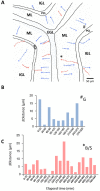Postnatal Migration of Cerebellar Interneurons
- PMID: 28587295
- PMCID: PMC5483635
- DOI: 10.3390/brainsci7060062
Postnatal Migration of Cerebellar Interneurons
Abstract
Due to its continuing development after birth, the cerebellum represents a unique model for studying the postnatal orchestration of interneuron migration. The combination of fluorescent labeling and ex/in vivo imaging revealed a cellular highway network within cerebellar cortical layers (the external granular layer, the molecular layer, the Purkinje cell layer, and the internal granular layer). During the first two postnatal weeks, saltatory movements, transient stop phases, cell-cell interaction/contact, and degradation of the extracellular matrix mark out the route of cerebellar interneurons, notably granule cells and basket/stellate cells, to their final location. In addition, cortical-layer specific regulatory factors such as neuropeptides (pituitary adenylate cyclase-activating polypeptide (PACAP), somatostatin) or proteins (tissue-type plasminogen activator (tPA), insulin growth factor-1 (IGF-1)) have been shown to inhibit or stimulate the migratory process of interneurons. These factors show further complexity because somatostatin, PACAP, or tPA have opposite or no effect on interneuron migration depending on which layer or cell type they act upon. External factors originating from environmental conditions (light stimuli, pollutants), nutrients or drug of abuse (alcohol) also alter normal cell migration, leading to cerebellar disorders.
Keywords: basket cell; cerebellar disorders; cerebellum; drug of abuse; environmental conditions; extracellular matrix; granule cell; interneuron; live-cell imaging; migration; neuropeptides; nutrients; postnatal development; stellate cell.
Conflict of interest statement
The authors declare no conflicts of interest.
Figures






Similar articles
-
Cortical-layer-specific effects of PACAP and tPA on interneuron migration during post-natal development of the cerebellum.J Neurochem. 2014 Jul;130(2):241-54. doi: 10.1111/jnc.12714. Epub 2014 Apr 19. J Neurochem. 2014. PMID: 24646324
-
Cerebellar cortical-layer-specific control of neuronal migration by pituitary adenylate cyclase-activating polypeptide.Neuroscience. 2007 May 11;146(2):697-712. doi: 10.1016/j.neuroscience.2007.02.025. Epub 2007 Mar 23. Neuroscience. 2007. PMID: 17383102 Free PMC article.
-
Somatostatin and pituitary adenylate cyclase-activating polypeptide (PACAP): two neuropeptides potentially involved in the development of the rat cerebellum.Ann Endocrinol (Paris). 1994;55(6):243-7. Ann Endocrinol (Paris). 1994. PMID: 7864580
-
The neuropeptide pituitary adenylate cyclase-activating polypeptide exerts anti-apoptotic and differentiating effects during neurogenesis: focus on cerebellar granule neurones and embryonic stem cells.J Neuroendocrinol. 2007 May;19(5):321-7. doi: 10.1111/j.1365-2826.2007.01537.x. J Neuroendocrinol. 2007. PMID: 17425606 Review.
-
Cellular and molecular mechanisms of cerebellar granule cell migration.Cell Biochem Biophys. 2003;37(3):213-34. doi: 10.1385/cbb:37:3:213. Cell Biochem Biophys. 2003. PMID: 12625628 Review.
Cited by
-
Induction of cerebellar cortical neurogenesis immediately following valproic acid exposure in ferret kits.Front Neurosci. 2023 Dec 7;17:1318688. doi: 10.3389/fnins.2023.1318688. eCollection 2023. Front Neurosci. 2023. PMID: 38130693 Free PMC article.
-
The Regulatory Roles of Cerebellar Glycosphingolipid Microdomains/Lipid Rafts.Int J Mol Sci. 2023 Mar 14;24(6):5566. doi: 10.3390/ijms24065566. Int J Mol Sci. 2023. PMID: 36982638 Free PMC article. Review.
-
Developmentally Transient CB1Rs on Cerebellar Afferents Suppress Afferent Input, Downstream Synaptic Excitation, and Signaling to Migrating Neurons.J Neurosci. 2020 Aug 5;40(32):6133-6145. doi: 10.1523/JNEUROSCI.1931-19.2020. Epub 2020 Jul 6. J Neurosci. 2020. PMID: 32631938 Free PMC article.
-
Review on PACAP-Induced Transcriptomic and Proteomic Changes in Neuronal Development and Repair.Int J Mol Sci. 2018 Mar 29;19(4):1020. doi: 10.3390/ijms19041020. Int J Mol Sci. 2018. PMID: 29596316 Free PMC article. Review.
-
Neonatal subarachnoid hemorrhage disrupts multiple aspects of cerebellar development.Front Mol Neurosci. 2023 Apr 28;16:1161086. doi: 10.3389/fnmol.2023.1161086. eCollection 2023. Front Mol Neurosci. 2023. PMID: 37187957 Free PMC article.
References
-
- Ramón y Cajal S. Cervelet, cerveau moyen, rétine, couche optique, corps strié, écorce cérébrale générale et régionale, grand sympathique. In: Azoulay L., editor. Histologie du Système Nerveux de L’homme et des Vertébrés. 1st ed. Volume 2 Maloine A.; Paris, France: 1911.
Publication types
LinkOut - more resources
Full Text Sources
Other Literature Sources
Miscellaneous

